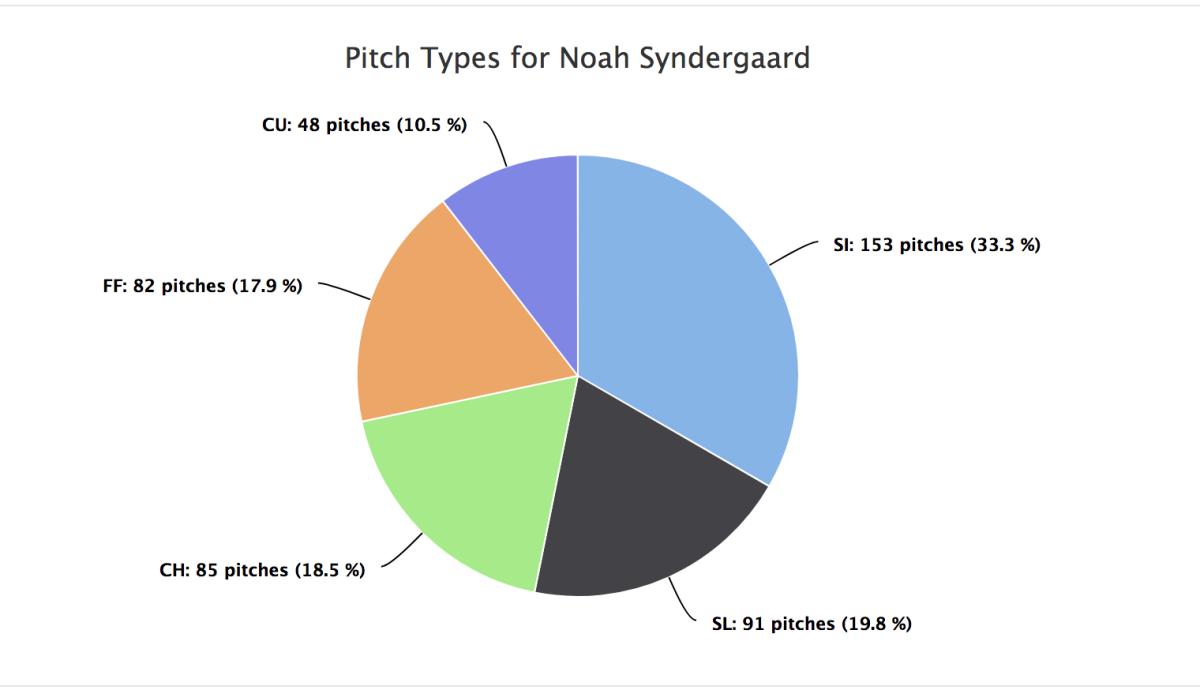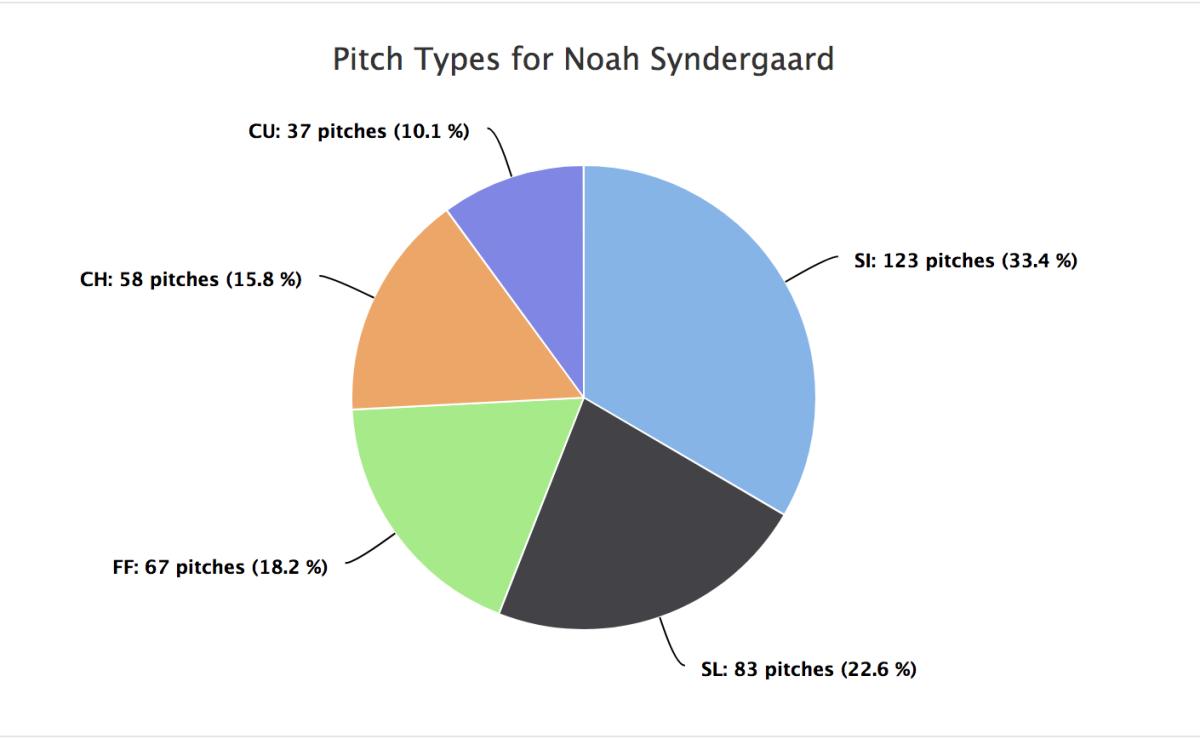Behold the Transformation of Noah Syndergaard

When Noah Syndergaard went down with a torn lat last April, he took more than just the Mets season down with him. He also scuttled what was to be one of the most interesting experiments in baseball.
We didn’t get to see it, but Syndergaard and the Mets were remaking one of the league’s most dominant pitchers in real time, under the hypothesis that a more diverse pitch mix would make him even better. Syndergaard spent the first two seasons of his career as nearly unhittable, totaling a 2.89 ERA, 2.72 FIP, 1.10 WHIP and 28.5% strikeout rate in 333 2/3 innings. Could he actually get any better than that? Syndergaard and the Mets decided the risk was worth it more than a year ago, but we’re just now getting to see the hypothesis tested in full. It is succeeding, perhaps beyond anything the pitcher and team could have imagined. Call it The Queens Project.
Before getting to the nuts and bolts of the Project, we must first lay out the details of the control phase. Syndergaard arrived in the majors in 2015, armed with arguably the best pure stuff in the league, highlighted by a four-seam fastball that lived in the high-90s. Syndergaard loved his fastball and leaned on it heavily. In 2015, he threw it 37.9% of the time according to Statcast, more than any other pitch in his arsenal. In 2016, when he went to the All-Star Game and pitched to a 2.60 ERA, MLB-leading 2.29 FIP and 1.15 WHIP with a 29.3% strikeout rate, he had the fastball to thank, throwing it a whopping 67.8% of the time that season. Now, that admittedly sounds high to the point that Statcast’s pitch tracking was a bit off. Still, all other tracking services had Syndergaard’s four-seamer comprising an easy plurality of his pitches. No matter the exact percentage, that’s the important takeaway.
In sum, Syndergaard needed two years to establish himself as one of the best pitchers in baseball, and he did it with what might have been the game’s best four-seam fastball. There’s our control phase.
Syndergaard could have gone on dominating the best hitters in the world with his fastball for the next decade, but he and the team went back to the drawing board before the 2017 season. He came out of the gates last year looking like a completely different pitcher. His first start that year came on April 3 against the Braves. He dominated the helpless Braves in that outing, tossing six shutout innings, allowing five hits while striking out seven and walking nary a batter. That, of course, was no surprise. The way he did it, however, was anything but expected.
Syndergaard threw 86 pitches in that start. Four, yes four, of them were four-seam fastballs. He threw 39 sinkers and 28 sliders in the outing, and even threw more changeups than four-seamers. With that, the experiment was up and running.
The lat injury cut short Syndergaard’s season, but in just 30 1/3 innings it was clear he was becoming a different pitcher. Here’s his pitch mix from last season, courtesy of Statcast. For the uninitiated, FF denotes four-seam fastball.

The four-seamer was still a key pitch for Syndergaard, but fell remained behind the sinker, slider and change, in terms of usage. To be fair, it was a 30-inning sample, during which Syndergaard was dealing with an injury, at least in part. It was possible that he was compensating for the injury by reining in his fastball, and that he’d revert to his previous ways this year with the lat now completely repaired. This is where the experiment really takes off.
The Syndergaard of 2018 looks a whole lot like the one we saw for just 30 1/3 innings last year. Here’s his pitch mix, again courtesy of Statcast.

The four-seamer has jumped the change early on this season but the sinker and slider still make up a majority of Syndergaard’s pitches. There’s nothing wrong with the four-seamer. Just ask Dexter Fowler.
Or Jonathan Villar.
Or Domingo Santana.
When your stuff is as powerful and filthy as Syndergaard’s, you’re doing yourself, and the entire baseball-loving world, a disservice by not opening up the repertoire. Syndergaard’s four-seamer is always going to be a weapon, but MLB hitters can figure out 98 if they don’t have to worry about anything else. Hitters have always had to worry about something else when facing Syndergaard going back to his rookie year, but now it’s the fastball that acts as a secondary offering, and that’s terrifying.
Let’s get a look at some of Syndergaard’s other stuff in action. A few innings after he blew his four-seamer past Dexter Fowler on Opening Day, he made Tommy Pham look silly on a 1–2 slider. Pham, for the record, is hitting everything in sight, slashing .323/.440/.468 going into play Thursday. I guess this pitch wasn’t in sight.
Syndergaard’s changeup has always been an important offering, as it is for many flamethrowers. When you can show a hitter the same arm action but have the pitch come in at 88-89 mph with glove-side tail, rather than 98-99 mph, you’re going to want to use it. The change has gained pitch share over the last two seasons, however, with Syndergaard now throwing it about 16% of the time. He can use it to hitters from both sides of the plate, as we will see below with help from Aaron Altherr and Travis Shaw.
That change to Shaw is just silly. I could write an entire column about it, but we don’t have time for that here. We have to move on to the sinker. Pitches that light up the radar gun at 97 and 98 mph really shouldn’t be able to move like this. I mean, give the hitter a chance, right? How is anyone supposed to stay on a pitch that looks like this, with this kind of location?
Or this?
Or this?
The Mets already had themselves an ace, and then they attempted baseball’s version of splitting the atom. The Queens Project was a rousing success, and from it came one of the most dominant pitchers in all of baseball. This version of Syndergaard is here to stay.
